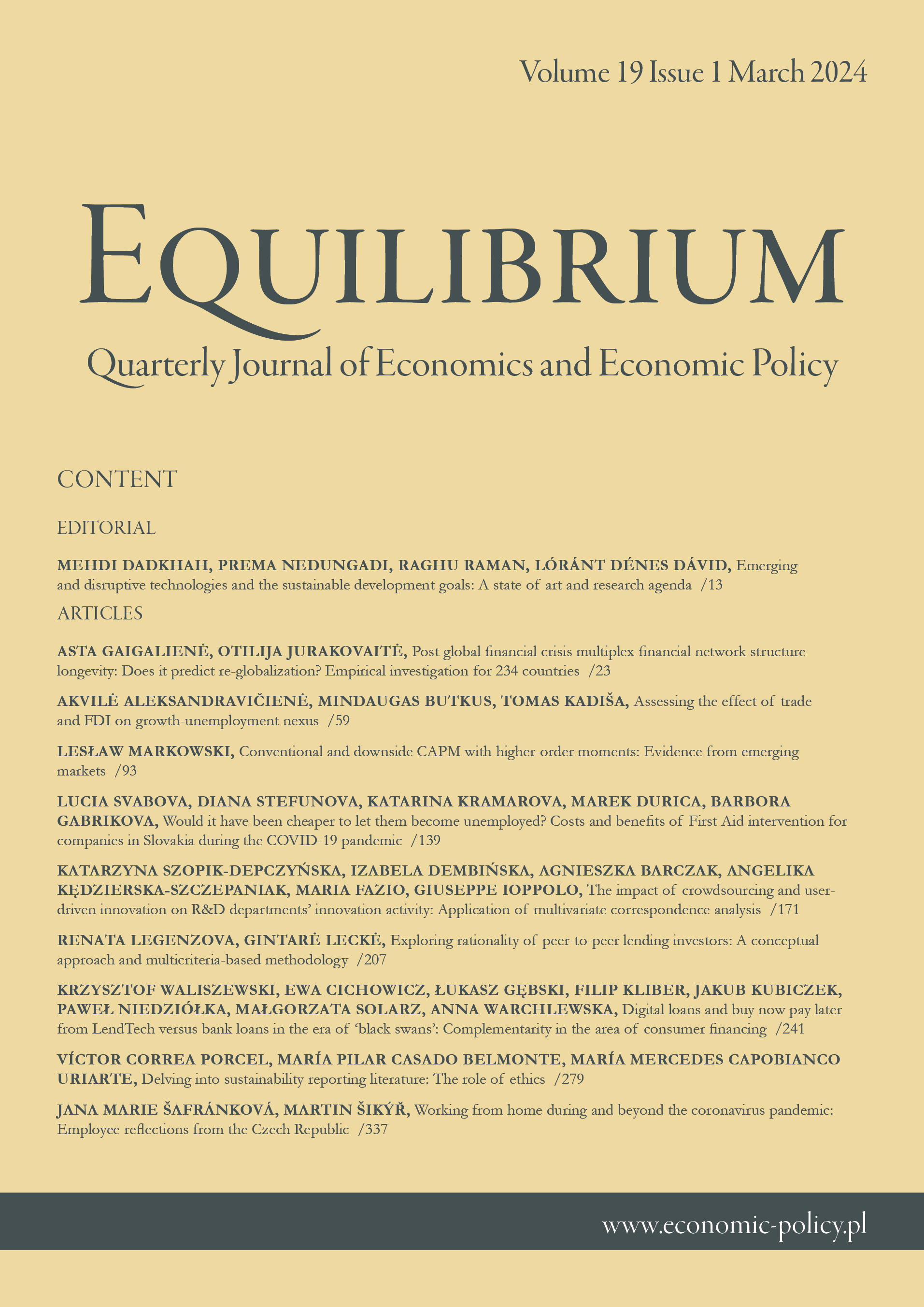乌克兰石油产品消费价格弹性的估计
IF 6.2
Q1 ECONOMICS
Equilibrium-Quarterly Journal of Economics and Economic Policy
Pub Date : 2020-06-24
DOI:10.24136/eq.2020.015
引用次数: 1
摘要
研究背景:工业国家石油产品市场的分析师认为,不同时期的需求弹性不同,这就产生了一种假设,即在过去几十年中,随着石油产品价格的变化,行为和结构因素改变了消费者的反应。本文的目的:本文的目的是研究需求和价格的弹性,以确定重大社会经济冲击后石油市场消费者行为的变化,并建立弹性变化与价格波动之间的相关性,以乌克兰石油产品市场为例。方法:基于乌克兰石油产品市场的时间序列,建立了评估需求弹性的静态和动态模型。根据扩展的Dickey-Fuller检验,发现石油产品需求的时间序列是非平稳的,而第一差分的时间序列则是平稳的;此外,消费、收入和价格的时间序列之间的协整事实是通过Johansson检验建立的。这使得构建共同整合依赖性成为可能,反过来又允许开发评估石油产品需求弹性的模型,在此基础上建立对消费者行为变化的客观评估。对2008年至2018年期间石油产品价格波动的月度计算分析表明,2014年初至2015年年中期间,波动值异常增加。截至2014年初和2015年下半年的两个时期的价格和需求弹性估计值与2014年初至2015年年中的相应弹性值有很大差异。调查结果和附加值:乌克兰市场石油产品的收入弹性和价格弹性评估是通过三个共同整合模型获得的,包括短期和长期,分别针对之前定义的三个时间间隔。其中一个时期的特点是价格高度波动,有条件地称为危机,弹性值与其他两个时期的相应值明显不同,特别是价格弹性为-0.383,长期债券为1.068。在其他两个时期,价格弹性分别为0.543,危机前长期弹性为0.274,价格弹性为-0.470,危机后长期弹性为0.235。对于相同的定义区间,短期和动态模型都获得了适当的弹性估计。对这些估计值的比较表明,危机前和危机后区间的弹性值接近,与危机区间的弹性估计值存在显著差异。因此,研究发现,弹性的显著变化伴随着价格波动的增加。本文章由计算机程序翻译,如有差异,请以英文原文为准。
Estimation of the price elasticity of petroleum products’ consumption in Ukraine
Research background: The analysts of the petroleum product markets of industrial countries believe that the elasticity of demand varies at different periods, which gave rise to the hypothesis that behavioral and structural factors have changed the consumers’ reaction during the last few decades, with a change in prices of petroleum products. Purpose of the article: The purpose of this article is to study the elasticity of demand and prices in order to identify changes in consumer behavior in the oil market after significant socio-economic shocks and to establish a correlation between changes in elasticity and price volatility, with the Ukrainian petroleum products market as an illustrative example. Methods: Based on the time series of the petroleum product market of Ukraine, static and dynamic models for assessing the demand elasticity were constructed. It was found that the time series of demand for petroleum products is non-stationary but then the time series of the first differences is stationary according to the extended Dickey-Fuller test; further, the fact of co-integration between time series of consumption, income, and prices was established by the Johansson test. This made it possible to construct co-integration dependence, allowing, in turn, the development of models for assessing the elasticity of demand for petroleum products, on the basis of which objective assessments of changes in consumer behavior were established. Analysis of the monthly calculation of petroleum products’ price volatility during the period 2008 to 2018 has showed that the values of volatility increased abnormally in the period between the beginning of 2014 and the middle of 2015. The estimates of price and demand elasticities obtained for the two periods up to the beginning of 2014 and the second half of 2015 differ significantly from the values of the corresponding elasticities between the beginning of 2014 and the middle of 2015. Findings & Value added: Assessments of income elasticities and price elasticities for petroleum products in the Ukrainian market were obtained by three co-integration models, both short and long term, for each of the three previously defined time intervals. In one of them, characterized by a high level of price volatility conditionally referred to as a crisis, the value of elasticities differed markedly from the corresponding values in the other two periods, in particular, -0.383 for price elasticity and 1.068 for a long-term bond. In the other two periods, these were, respectively, 0.543 for price elasticity and 0.274 for long-term pre-crisis elasticity, and -0.470 for price elasticity and 0.235 for long-term post-crisis elasticity. Appropriate elasticity estimates were obtained for both the short-run and the dynamic model, for the same defined intervals. A comparison of these estimates showed the closeness of the values of elasticities for the pre-crisis and post-crisis intervals and a marked difference from the estimates of the elasticities in the crisis interval. Thus, it was found that a significant change in elasticities is accompanied by an increase in price volatility.
求助全文
通过发布文献求助,成功后即可免费获取论文全文。
去求助
来源期刊
CiteScore
9.20
自引率
3.50%
发文量
28
审稿时长
36 weeks
期刊介绍:
Equilibrium. Quarterly Journal of Economics and Economic Policy is a scientific journal dedicated to economics, which is the result of close cooperation between the Instytut Badań Gospodarczych/Institute of Economic Research (Poland) and Polish Economic Society and leading European universities. The journal constitutes a platform for exchange of views of the scientific community, as well as reflects the current status and trends of world science and economy.
The journal especially welcome empirical articles making use of quantitative methods in: Macroeconomics and Monetary Economics, International Economics, Financial Economics and Banking, Public Economics, Business Economics, Labor and Demographic Economics, Economic Development, and Technological Change, and Growth.
Current most preferable topics and special issues:
The economics of artificial intelligence: business potentials and risks;
Digitalization and entrepreneurship in economics;
Sustainable socio-economic development, environmental and ecological economics;
Transition in the energy market (improving energy efficiency, alternative energy sources, renewable energy, energy security).

 求助内容:
求助内容: 应助结果提醒方式:
应助结果提醒方式:


